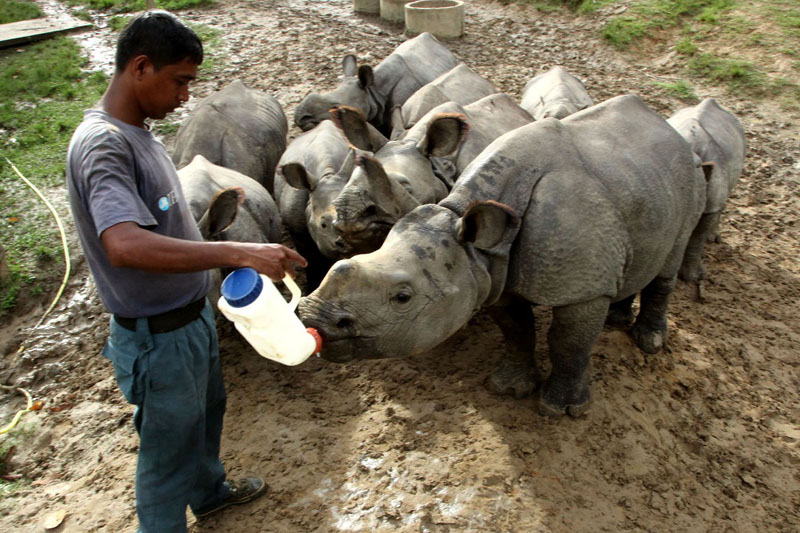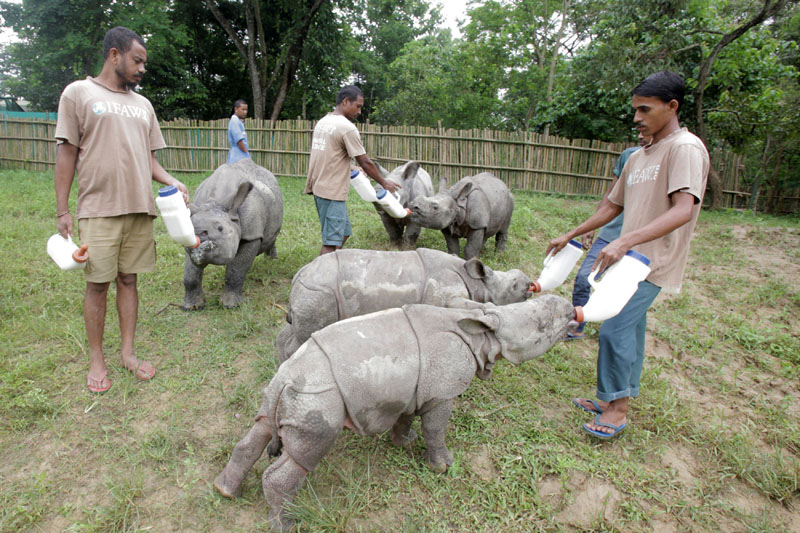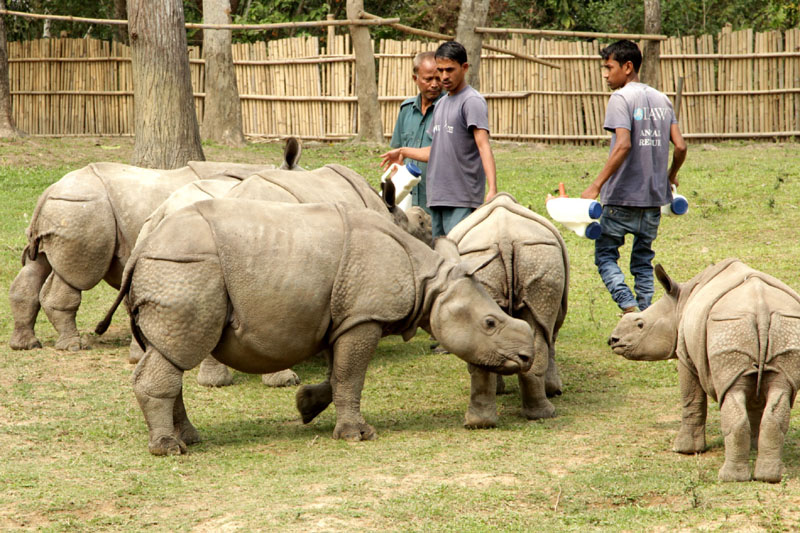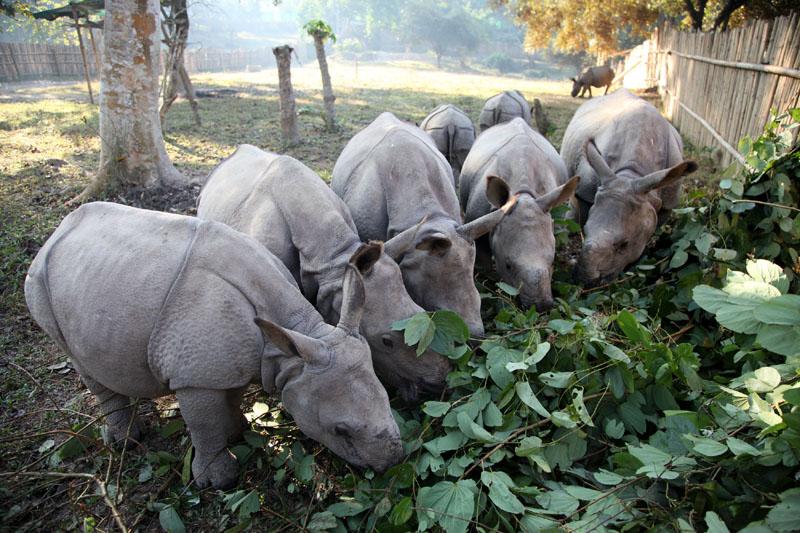Growing Wild: the rescued rhino calves
It’s been a year since Kaziranga National Park was inundated by the worst floods to have hit Assam in over a decade. Among the 100-plus wild animal emergencies that CWRC (the Centre for Wildlife Rehabilitation and Conservation: the wildlife rescue, treatment and rehabilitation centre run by Wildlife Trust of India (WTI), the International Fund for Animal Welfare (IFAW) and the Assam Forest Department near Kaziranga) and its Mobile Veterinary Service units attended during the floods last year, were eight orphaned rhino calves that were rescued and brought to the centre to be hand-raised.
The simultaneous long-term care of eight rhinos has been a massive challenge for the team at CWRC. In addition to the efforts of the centre’s animal keepers and veterinarians, the tremendous support received from individual and corporate supporters, the Government of Assam, the Kaziranga National Park Authority and people from all walks of life across Assam has been critical.
“I remember that a group of children from a remote school had given up a mid-day meal to buy milk formula for the rhino calves”, says Dr Rathin Barman, WTI Joint Director and centre-in-charge, CWRC. “There have been several such touching expressions of support. We extend our heartfelt gratitude to the people of Assam and all well-wishers for their support and encouragement over the past year.”
When the rhino calves were first brought to CWRC they were stabilised at the centre’s Large Animal Nursery. Once they had recovered from their flood-related trauma and injuries they were shifted to a small outdoor paddock attached to the nursery. Gradually, having acclimatised to the outdoors, they were introduced to three larger paddocks with a natural stream running through them. This allowed the calves to wallow and play – an important part of their natural developmental behaviour.
“The calves have grown fast”, says Dr Panjit Basumatary, the lead veterinarian at CWRC. “Importantly, they’ve experienced all four seasons now, in an approximation of their natural habitat. It was touching to see how the younger calves huddled close to the older ones at night to keep warm during the winter, as they would have with their mothers. Now, as they play in the mud, enjoy the rain or nap together as they would in their natural environment, we feel a sense of satisfaction that they are making good progress towards a life in the wild.”
CWRC currently has ten rhino calves under care. The eight calves rescued last year had already bonded with an older calf that was rescued in 2015. Another under care four- to six-month-old calf displaced by the monsoon floods was rescued from Burhapahar and brought to the centre earlier this month during Kaziranga flood 2017.
Random Stories
16 May 2017 - 11:14pm |
Robertson Tanti
A day long NDA coaching program was organized by Indian Army (Red Horn Division) of Borengajuli Army camp in collaboration with Bhergaon Block Development Committee at Bhergaon Sub-Divisional (Civil...
10 Jul 2017 - 9:31pm |
AT News Imphal
An unknown illness appeared to spread in the district as many as 49 people including children have reported becoming sick after an illness at the interior village of V Sinai on Monday. ...
23 Aug 2018 - 8:18am |
Shajid Khan
UDALGURI: Along with the rest of the nation the Muslim people of various parts of Udalguri celebrated Eid-ul-Zuha -the festival of sacrifice with religious fervour and enthusiasm on Saturday ,...
21 Jul 2020 - 5:46pm |
AT News
Guwahati: A local court in Guwahati on Tuesday jailed a student a day after the Sivasagar police arrested him for making "objectionable" remarks against the government in social media which has gone...
Other Contents by Author
Two sub-adult rhinos, Gopal and Hari have been shifted to Manas National Park from the Centre for Wildlife Rehabilitation and Conservation (CWRC), Kaziranga today. The rhinos will be released in the wild following a period of in situ acclimatisation in the UNESCO World Heritage Site. They follow the five rhinos - three females and two males that were hand-reared at CWRC and rehabilitated in Manas since 2006; the three females gave birth last year.CWRC is a wildlife rehabilitation facility jointly run by Assam Forest Department and International Fund for Animal Welfare - Wildlife Trust of India (IFAW-WTI).The two rhinos moved today - Gopal and Hari, both male, were less than a month old when...
Mayodia model Village popularly known as Tiwari Gaon which is far away from regular power connectivity is empowered with solar energy equipments by Wildlife Trust of India (WTI) in collaboration with the Department of Environment & Forest, Arunachal Pradesh with support from Europaeische Tierschutzstftung (ETS) on Sunday. This facility will reduce the long term power and electricity crisis faced by the villagers. This is for the first time that an NGO like WTI is providing the solar equipments to a model village in the vicinity of Mehao Wildlife Sanctuary (Mehao WLS) in Arunachal Pradesh in India.The beneficiaries received the solar equipment which was a total solar energy based...
The International Fund for Animal Welfare - Wildlife Trust of India (IFAW-WTI) in collaboration with Assam Forest Department is organising a four day ‘Disaster Relief Workshop and ERN meet’ for animal rescuers and rehabilitators from across the country, beginning today. “Preparation, and quick and coordinated action are key priorities to save lives during disasters, whether for humans or animals,” said Shannon Walajtys, Animal Rescue Manager, Disaster Response & Risk Reduction (DRRR), IFAW. “This workshop will not just train rehabilitators individually but will also strengthen the fraternity to mobilise coordinated action during disasters,”- she also added. The ERN...
Maheshwar Basumatary aka Ontai, an animal keeper with the International Fund for Animal Welfare - Wildlife Trust of India (IFAW-WTI)’s Greater Manas Conservation Project has been honoured with this year’s prestigious Sanctuary Asia Wildlife Service Award for his contributions to conservation in Bodoland. (The award will be given to him this evening at an event in Mumbai.)Born in the autonomous district of Bodoland in Assam, Ontai grew up amidst political unrest that afflicted the district till early 2000s. He got married at an early age of 19 without any job in hand. Soon after, unfortunately he lost his way and fell in company with the wrong crowd helping the poachers as trackers.“Those...
As part of the International Fund for Animal Welfare-Wildlife Trust of India (IFAW-WTI) Animal Action Education Programme, the young boys and girls of Kahitama High School, Bahbari High School and Manas M E School joined their teachers, local artists and members of theDepartment of Education, Bodoland Territorial Council (BTC) as they made their school walls explode with colour while painting their favourite animals all over them. The objective- to spread awareness on the plight of wildlife in Manas National Park. Already three schools have been covered under the campaign.The International Fund for Animal Welfare's Animal Action Education programme (IFAW-AAE) is operational in 18 countries...
Continuing efforts of conserving the last of India’s apes, the International Fund for Animal Welfare-Wildlife Trust of India (IFAW-WTI) team in collaboration with the Arunachal Pradesh State Forest Department successfully captured and released two eastern hoolock gibbons, over a two-day period, from the village of Dello to a safer and more suitable habitat in the Mehao WIldlife Sanctuary.Ipra Mekola, Arunachal Pradesh State Wildlife Advisory Member, who was part of the release team yesterday, remarked on the project’s efforts saying “Gibbons essentially live in strong familial units. Capturing every family is extremely difficult to begin with and the more complex the terrain, the more...
Under the IFAW: WTI Wildlife Crime Prevention Training programme, a total of 100frontline forest staff of Manas National Park, Manas Reserve Forest, Kachugaon Reserve Forest and Ripu Reserve Forest in Greater Manas are targeted to be trained and equipped in partnership with the Assam Forest Department and Bodoland Territorial Council (BTC). The first batch of 32 trainees among the four batches from all the three ranges of Manas National Park is undergoing training from Sunday.Greater Manas is a critical wildlife habitat along the Indo-Bhutan border in Bodoland, Assam, supporting a wide range of flora and fauna including the endangered Asian elephant, Royal Bengal tiger, greater one-horned...
Over a month since the migratory Amur falcons’ arrival in Nagaland, not a single bird has been killed in their roosting site in Doyang Reservoir, reports the Amur Falcon Protection Squad (AFPS) – a group of former hunters, who along with the Nagaland Forest Department staff are patrolling these areas to keep the birds safe. This remarkable turnaround - considering tens of thousands of falcons reportedly hunted last year - was brought about through joint initiatives implemented by the local communities, the Forest Department and NGOs including the Natural Nagas and Wildlife Trust of India (WTI). This includes daily patrol by the Forest Department staff and AFPS along the Doyang...
The Wildlife Conservation Division of Bhutan along with the International Fund for Animal Welfare – Wildlife Trust of India (IFAW-WTI) have launched a month-long training for around 450 forest rangers for effective wildlife crime prevention in the landlocked country.The skills learned will help the rangers deal with a wide range of issues to protect the country’s natural heritage including the tiger. Each staff will also be equipped with field kit sets (rucksack, winter jacket, rainsuit, water bottle, cap, sleeping bag) to help them in their daily duties, including specially-made kits for frontline staff working 5000 masl protecting the rare snow leopards.Sonam Wangchuk, Chief of the...
Three smooth-coated otter pups rescued from the floods in Kaziranga National Park last week are currently being hand-reared at the Centre for Wildlife Rehabilitation and Conservation (CWRC).The pups, all male, yet to open their eyes, were found floating on hyacinth leaves by local people in Mahpora (Dagaon) from the fringes of the National Park, last Friday.“The people apparently found the pups while they were fishing. They handed over the pups to the Forest Department staff, who called us to collect them as they could not locate the mother or their den,” said Dr Anjan Talukdar, International Fund for Animal Welfare – Wildlife Trust of India (IFAW-WTI) veterinarian.The pups are being bottle...










Add new comment